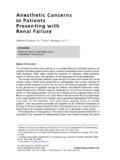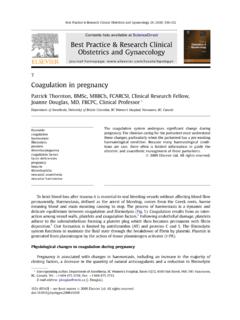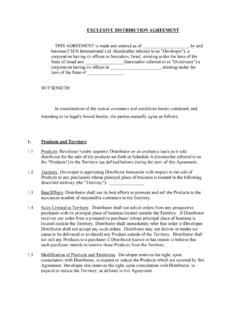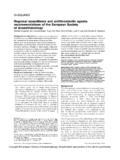Transcription of To Err Is Human - CSEN
1 To Err Is Human : Building a Safer Health SystemTo Err Is Human Building a Safer Health System Linda T. Kohn, Janet M. Corrigan, and Molla S. Donaldson, Editors Committee on Quality of Health Care in America INSTITUTE OF MEDICINE NATIONAL ACADEMY PRESS Washington, 1999 l Notice l Reviewers l Preface l Foreword l Acknowledgments l Contents l Executive Summary (1 of 34)12/4/2003 12:59:39 PMTo Err Is Human : Building a Safer Health SystemNOTICE: The project that is the subject of this report was approved by the Governing Board of the National Research Council, whose members are drawn from the councils of the National Academy of Sciences, the National Academy of Engineering, and the Institute of Medicine.
2 The members of the committee responsible for the report were chosen for their special competences and with regard for appropriate balance. Support for this project was provided by The National Research Council and The Commonwealth Fund. The views presented in this report are those of the Institute of Medicine Committee on the Quality of Health Care in America and are not necessarily those of the funding agencies. Library of Congress Cataloging-in-Publication Data To err is Human : building a safer health system / Linda T. Kohn, Janet M. Corrigan, and Molla S. Donaldson, editors. p. cm Includes bibliographical references and index. ISBN 0-309-06837-1 1. Medical errors--Prevention. I. Kohn, Linda T. II. Corrigan, Janet.
3 III. Donaldson, Molla S. 2000 99-088993 Additional copies of this report are available for sale from the National Academy Press, 2101 Constitution Avenue, , Box 285, Washington, DC 20055; call (800) 624-6242 or (202) 334-3313 in the Washington metropolitan area, or visit the NAP on-line bookstore at The full text of this report is available on line at For more information about the Institute of Medicine, visit the IOM home page at Copyright 2000 by the National Academy of Sciences. All rights reserved. Printed in the United States of America The serpent has been a symbol of long life, healing, and knowledge among almost all cultures and religions since the beginning of recorded history. The (2 of 34)12/4/2003 12:59:39 PMTo Err Is Human : Building a Safer Health Systemserpent adopted as a logotype by the Institute of Medicine is a relief carving from ancient Greece, now held by the Staatliche Museen in Berlin.
4 The National Academy of Sciences is a private, nonprofit, self-perpetuating society of distinguished scholars engaged in scientific and engineering research, dedicated to the furtherance of science and technology and to their use for the general welfare. Upon the authority of the charter granted to it by the Congress in 1863, the Academy has a mandate that requires it to advise the federal government on scientific and technical matters. Dr. Bruce M. Alberts is president of the National Academy of Sciences. The National Academy of Engineering was established in 1964, under the charter of the National Academy of Sciences, as a parallel organization of outstanding engineers. It is autonomous in its administration and in the selection of its members, sharing with the National Academy of Sciences the responsibility for advising the federal government.
5 The National Academy of Engineering also sponsors engineering programs aimed at meeting national needs, encourages education and research, and recognizes the superior achievements of engineers. Dr. William A. Wulf is president of the National Academy of Engineering. The Institute of Medicine was established in 1970 by the National Academy of Sciences to secure the services of eminent members of appropriate professions in the examination of policy matters pertaining to the health of the public. The Institute acts under the responsibility given to the National Academy of Sciences by its congressional charter to be an adviser to the federal government and, upon its own initiative, to identify issues of medical care, research, and education.
6 Dr. Kenneth I. Shine is president of the Institute of Medicine. The National Research Council was organized by the National Academy of Sciences in 1916 to associate the broad community of science and technology with the Academy's purposes of furthering knowledge and advising the (3 of 34)12/4/2003 12:59:39 PMTo Err Is Human : Building a Safer Health Systemfederal government. Functioning in accordance with general policies determined by the Academy, the Council has become the principal operating agency of both the National Academy of Sciences and the National Academy of Engineering in providing services to the government, the public, and the scientific and engineering communities. The Council is administered jointly by both Academies and the Institute of Medicine.
7 Dr. Bruce M. Alberts and Dr. William A. Wulf are chairman and vice chairman, respectively, of the National Research Council. COMMITTEE ON QUALITY OF HEALTH CARE IN AMERICA WILLIAM C. RICHARDSON (Chair), President and CEO, Kellogg Foundation, Battle Creek, MI DONALD M. BERWICK, President and CEO, Institute for Healthcare Improvement, Boston J. CRIS BISGARD, Director, Health Services, Delta Air Lines, Inc., Atlanta LONNIE R. BRISTOW, Past President, American Medical Association, Walnut Creek, CA CHARLES R. BUCK, Program Leader, Health Care Quality and Strategy Initiatives, General Electric Company, Fairfield, CT CHRISTINE K. CASSEL, Professor and Chairman, Department of Geriatrics and Adult Development, Mount Sinai School of Medicine, New York City MARK R.
8 CHASSIN, Professor and Chairman, Department of Health Policy, Mount Sinai School of Medicine, New York City MOLLY JOEL COYE, Senior Vice President and Director, West Coast (4 of 34)12/4/2003 12:59:39 PMTo Err Is Human : Building a Safer Health SystemOffice, The Lewin Group, San Francisco DON E. DETMER, Dennis Gillings Professor of Health Management, University of Cambridge, UK JEROME H. GROSSMAN, Chairman and CEO, Lion Gate Management Corporation, Boston BRENT JAMES, Executive Director, Intermountain Health Care, Institute for Health Care Delivery Research, Salt Lake City, UT DAVID McK. LAWRENCE, Chairman and CEO, Kaiser Foundation Health Plan, Inc., Oakland, CA LUCIAN LEAPE, Adjunct Professor, Harvard School of Public Health ARTHUR LEVIN, Director, Center for Medical Consumers, New York City RHONDA ROBINSON-BEALE, Executive Medical Director, Managed Care Management and Clinical Programs, Blue Cross Blue Shield of Michigan, Southfield JOSEPH E.
9 SCHERGER, Associate Dean for Clinical Affairs, University of California at Irvine College of Medicine ARTHUR SOUTHAM, Partner, 2C Solutions, Northridge, CA MARY WAKEFIELD, Director, Center for Health Policy and Ethics, George Mason University GAIL L. WARDEN, President and CEO, Henry Ford Health System, Detroit Study Staff JANET M. CORRIGAN, Director, Division of Health Care Services, Director, Quality of Health Care in America Project (5 of 34)12/4/2003 12:59:39 PMTo Err Is Human : Building a Safer Health SystemMOLLA S. DONALDSON, Project Co-Director LINDA T. KOHN, Project Co-Director TRACY McKAY, Research Assistant KELLY C. PIKE, Senior Project Assistant Auxiliary Staff MIKE EDINGTON, Managing Editor KAY C. HARRIS, Financial Advisor SUZANNE MILLER, Senior Project Assistant Copy Editor FLORENCE POILLON Reviewers This report has been reviewed in draft form by individuals chosen for their diverse perspectives and technical expertise, in accordance with procedures approved by the National Research Council's Report Review Committee.
10 The purpose of this independent review is to provide candid and critical comments that will assist the Institute of Medicine in making the published report as sound as possible and to ensure that the report meets institutional standards for objectivity, evidence, and responsiveness to the study charge. The review comments and the draft manuscript remain confidential to protect the integrity (6 of 34)12/4/2003 12:59:39 PMTo Err Is Human : Building a Safer Health Systemof the deliberative process. The committee wishes to thank the following individuals for their participation in the review of this report: GERALDINE BEDNASH, Executive Director, American Association of Colleges of Nursing, Washington, DC PETER BOUXSEIN, Visiting Scholar, Institute of Medicine, Washington, DC JOHN COLMERS, Executive Director, Maryland Health Care Cost and Access Commission, Baltimore JEFFREY COOPER, Director, Partners Biomedical Engineering Group, Massachusetts General Hospital, Boston ROBERT HELMREICH, Professor, University of Texas at Austin LOIS KERCHER, Vice President for Nursing, Sentara-Virginia Beach General Hospital, Virginia Beach, VA GORDON MOORE, Associate Chief Medical Officer, Strong Health, Rochester, NY ALAN NELSON, Associate Executive Vice President, American College of Physicians/American Society of Internal Medicine.









